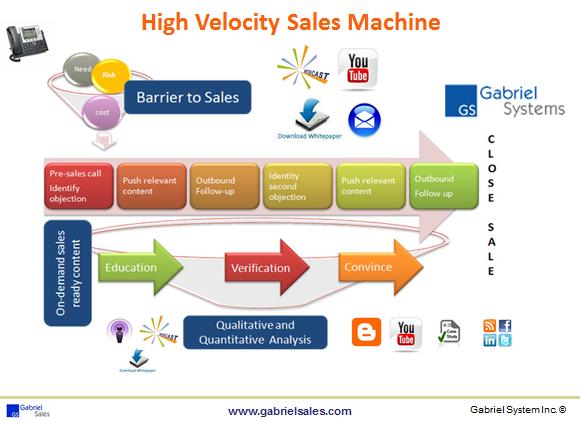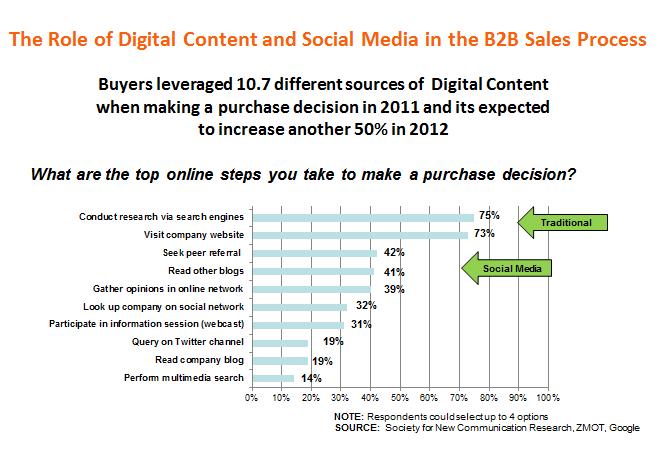 We are calling this a Top 10 demand generation strategies list, but as we went through the strategies, we felt the need to give your b to b demand gen amplifier one more notch and took it to 11. This blog post is a quick reference for your company to build a successful b to b demand generation practice focused on improving your ROI statement.
We are calling this a Top 10 demand generation strategies list, but as we went through the strategies, we felt the need to give your b to b demand gen amplifier one more notch and took it to 11. This blog post is a quick reference for your company to build a successful b to b demand generation practice focused on improving your ROI statement.
1. Don’t wait to follow up on leads. You spend $15K, $30K, $100K plus on a trade show. You spend money on inbound pay-per-click, or publishers etc. If the marketing department is in charge of sharing the leads they may score and then share with an internal team or an outside vendor. If the sales team is in charge they will often prioritize by gut. We understand the value of both approaches. You want to call the best prospects first. However, generally what occurs is that lag time of a few hours can turn into days and weeks. That lag time hurts especially if your leads are in a highly competitive industry (getting there first improves your closing % by as much a 100%), your sales cycle is 90 days or less (first 3 get short listed), or your leads are driven by search engine marketing (could be a “just in time” need). Many marketers we talk to will proudly say “we call on incoming leads within a week.” Guaranteed they have never done a study on the effects of that delay.
2. Make those extra calls. Don’t give up on leads after 1 or 2 calls if you don’t connect. This is especially challenging for sales reps that are not supported by a demand gen inside rep. A sales reps’ job is to close business. If they have deals moving this quarter they don’t always have the time to make that third or fourth call. As a b to b demand generation outsourced company and a sales outsourcing solution provider we have done countless studies that have shown that the 3rd, 4th and sometimes 5th attempt is where the payoff comes. This is especially true the more senior the decision maker. They are just tougher to reach.
3. Have an additional piece of content. Have a new offer after every call to keep the prospect engaged and give your rep “a reason to follow up” to ask them what they thought. Bottom line is that content keeps a deal moving without needing to get your senior talent on the phone to educate the prospect. It provides a reason for dialogue. It allows you to keep asking “what else are you curious about or what can I share to help you”. It allows you to talk about their needs while you share your position as well. Selling is about the customer not you and this allows you to kill two birds with one stone.
4. Lead with more than just a demo as your initial offer. As a sales outsourcing company we understand that clients want us to transact now but it doesn’t always work that way. Their strategy is often to get the prospect in that demo as quickly as possible and if the prospect is ready to do that great! However smart b to b demand generation requires that you also have an offer for prospects that aren’t ready to make that commitment. The prospect is not unintelligent. They know that getting into that demo starts them on the path towards committing to buy. They may not be ready to make that decision yet and they don’t want to waste your time or theirs, so give them a way to engage that is a bit softer and slower.
5. Educate but keep the costs down. We live in competitive times so many businesses’ marketing efforts focus on the product and ignore the value of educating their prospects so that they realize the value they are offered. To win deals and ensure you are receiving a top dollar for your product or service the customer needs to understand the value you are driving for their business. To explain that value the customer needs and wants understand that value. So you need to help your customer by helping your customers get what they want – which is fair, independent and “neutral” views that help them take informed and unbiased decisions. This is quick content to create especially for your senior sales executives if you can get them blogging. What is common sense for you as the expert, especially when it comes to competition and the “internal independent research” available, is often very valuable new information for you customer.
6. Don’t forget about your existing customers. They are the core of your business, without them you don’t exist. So the core of your business is that successful relationship. Keep building on that relationship and continue to share content with them to build even more trust. This will organically turn them into advocates. They tweet, they belong to Linked-In, Google +. Don’t ask for them to do it. Just make it easy for them. Referrals work in new and unexpected ways so simply be surprised and especially grateful when they ask to contribute content for you.
7. Listen to your sales team and your prospects to generate your content strategy. In many cases, the sales team understands what the customer needs before the customer does. This is especially true if you have a disruptive solution moving into an existing market or an existing solution moving into new markets. Creating a great deal of content quickly is not tough. If you listen to your prospects objections and the same questions or concerns come up several times turn it into a blog post. You can than take that sales conversation to address other prospects’ needs and, even more importantly to your b to b demand generation effort, take that “sales conversation” into the social media conversation.
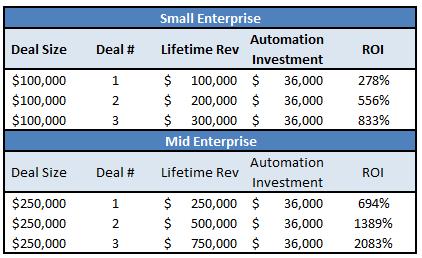 8. Know your the inflection point for your ROI statement when implementing a Marketing Automation Platform and Nurturing program. A platform (as an outsourced sales company we recommend Pardot) cost $16K. A 3 series webinar will cost you roughly $6K-$10K in house or external. Basic blog content creation will cost about $12K. And planning, database integration and implementation can range from$12K to $24K. So all in you are looking at $72K if you are starting from scratch. If you are following the best practices laid out above or you have implemented a sales outsourcing solution, or b to b demand generation solution with Gabriel Sales, you will already have a great deal of the content planning you need so an implementation is roughly $24K-$36K. You can do the math from there (we have a back of the envelope chart below to help). If your average deal size is $100K + the ability to track digital content and the time savings alone for the senior rep makes it an easy decision to pull the trigger. For smaller and shorter sales cycles it really comes down to how many leads you have in your database because countless studies have shown that if your product has legs you can expect to convert at least 1% to 3% of the leads that were initially just curious.
8. Know your the inflection point for your ROI statement when implementing a Marketing Automation Platform and Nurturing program. A platform (as an outsourced sales company we recommend Pardot) cost $16K. A 3 series webinar will cost you roughly $6K-$10K in house or external. Basic blog content creation will cost about $12K. And planning, database integration and implementation can range from$12K to $24K. So all in you are looking at $72K if you are starting from scratch. If you are following the best practices laid out above or you have implemented a sales outsourcing solution, or b to b demand generation solution with Gabriel Sales, you will already have a great deal of the content planning you need so an implementation is roughly $24K-$36K. You can do the math from there (we have a back of the envelope chart below to help). If your average deal size is $100K + the ability to track digital content and the time savings alone for the senior rep makes it an easy decision to pull the trigger. For smaller and shorter sales cycles it really comes down to how many leads you have in your database because countless studies have shown that if your product has legs you can expect to convert at least 1% to 3% of the leads that were initially just curious. 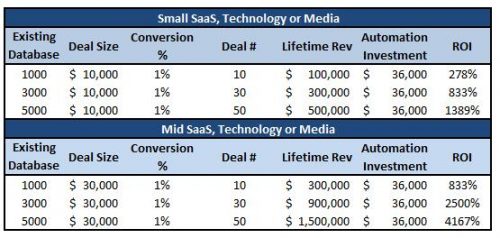
9. Create digital landing pages for your sales reps to use that are customer centric. As your content grows create a resource page that is customer centric. Design them to help the customer make decisions. Give them educational content, evaluation content and verification content in one easy to find area. Combine your general educational content (70%) with some vertical specific content (30%) so you are speaking directly to that particular need or pain area. Don’t make the content just about you make it about them; around the needs of your customer by decision maker type. Make it easy for your customers to find what they need, and almost as important, make your brochure dynamic so you are not wasting your sales reps valuable phone time keeping up with new additions to your marketing mix. Keep them focused on selling. Gabriel Sales has developed a simple to implement landing page engine that can be up and running for you in a matter of weeks to jump start this process.
10. Re-purpose the digital land page to generate inbound traffic and remove barriers to engaging. The “sales” conversation, the digital conversation and the “social media” conversation are the same conversation. The objections your reps hear and address are the same that customers who haven’t found you yet have. Make it easy for them to find you and maximize your sales content investment by driving traffic to that page with long tail SEO and PPC campaigns that keep your costs down. Keep the language on the page focused on the customer using the language of “your” and “you” not “we” and “us”. And finally keep the requirements of your form down to the basics – customer name andemail address. Keep any other fields optional.
11. BONUS: Lead Generation Reps and Demand Generation Reps have different tasks and need different skills sets. The new rules of sales engagement require your demand generation reps and your sales reps to have different skill sets. Lead gen reps are often calling cold. Their scripts are different, their call volume is different and their personality is different from what is required by reps moving inbound leads forward. Demand gen reps are there to facilitate. Lead gen reps are there to put leads in the pipe. Be conscious of the difference and either train your lead gen reps in the new rules of sales engagement (so they are not creepy or overly assertive) or hire a different rep to move deals from Marketing Qualified to Sales Qualified.
For a full overview of why we feel it makes strategic and executional sense to have your sales team involved in your sales content marketing strategy, strategic approaches to team integration and a road map for fluid communication, we invite you to visit our blog section.
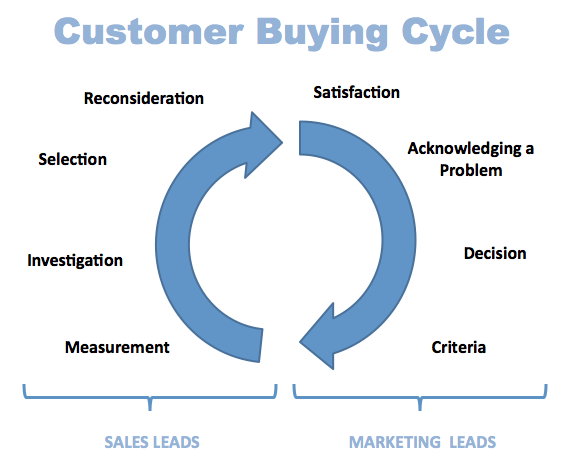


 This blog will discuss a competitive advantage and a Best Practice for B2B Lead Generation for 2013. As a qualified sales lead generation company, we were surprised how many B2B marketers still had a black box correlating b2b lead generation to sales return on investment. We will let the graphics below demonstrate how easy it could be for your business to gain a leg up on your competition by simply implementing a tool like Pardot, as a best practice for B2B lead Generation.
This blog will discuss a competitive advantage and a Best Practice for B2B Lead Generation for 2013. As a qualified sales lead generation company, we were surprised how many B2B marketers still had a black box correlating b2b lead generation to sales return on investment. We will let the graphics below demonstrate how easy it could be for your business to gain a leg up on your competition by simply implementing a tool like Pardot, as a best practice for B2B lead Generation.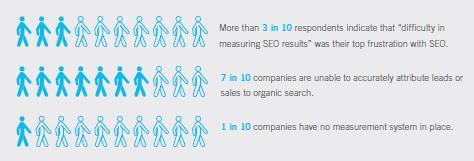 “For B2B, lead generation is the top objective, and SEO is twice as effective as PPC or SMM for this purpose.”
“For B2B, lead generation is the top objective, and SEO is twice as effective as PPC or SMM for this purpose.”

 We are calling this a Top 10 demand generation strategies list, but as we went through the strategies, we felt the need to give your b to b demand gen amplifier one more notch and took it to 11. This blog post is a quick reference for your company to build a successful b to b demand generation practice focused on improving your ROI statement.
We are calling this a Top 10 demand generation strategies list, but as we went through the strategies, we felt the need to give your b to b demand gen amplifier one more notch and took it to 11. This blog post is a quick reference for your company to build a successful b to b demand generation practice focused on improving your ROI statement. 8. Know your the inflection point for your ROI statement when implementing a Marketing Automation Platform and Nurturing program. A platform (as an outsourced sales company we recommend Pardot) cost $16K. A 3 series webinar will cost you roughly $6K-$10K in house or external. Basic blog content creation will cost about $12K. And planning, database integration and implementation can range from$12K to $24K. So all in you are looking at $72K if you are starting from scratch. If you are following the best practices laid out above or you have implemented a sales outsourcing solution, or b to b demand generation solution with Gabriel Sales, you will already have a great deal of the content planning you need so an implementation is roughly $24K-$36K. You can do the math from there (we have a back of the envelope chart below to help). If your average deal size is $100K + the ability to track digital content and the time savings alone for the senior rep makes it an easy decision to pull the trigger. For smaller and shorter sales cycles it really comes down to how many leads you have in your database because countless studies have shown that if your product has legs you can expect to convert at least 1% to 3% of the leads that were initially just curious.
8. Know your the inflection point for your ROI statement when implementing a Marketing Automation Platform and Nurturing program. A platform (as an outsourced sales company we recommend Pardot) cost $16K. A 3 series webinar will cost you roughly $6K-$10K in house or external. Basic blog content creation will cost about $12K. And planning, database integration and implementation can range from$12K to $24K. So all in you are looking at $72K if you are starting from scratch. If you are following the best practices laid out above or you have implemented a sales outsourcing solution, or b to b demand generation solution with Gabriel Sales, you will already have a great deal of the content planning you need so an implementation is roughly $24K-$36K. You can do the math from there (we have a back of the envelope chart below to help). If your average deal size is $100K + the ability to track digital content and the time savings alone for the senior rep makes it an easy decision to pull the trigger. For smaller and shorter sales cycles it really comes down to how many leads you have in your database because countless studies have shown that if your product has legs you can expect to convert at least 1% to 3% of the leads that were initially just curious. 
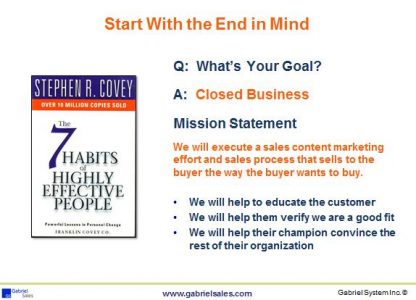 This blog is the second part of a three part series that discusses the difference between sales content marketing and other types of marketing and how you can approach creating a successful B2B Demand Generation Sales Marketing Alignment solution (with or without outsourcing) by aligning sales and marketing. In this blog we provide a simple framework for driving successful B2B Demand Generation Sales Marketing Alignment.
This blog is the second part of a three part series that discusses the difference between sales content marketing and other types of marketing and how you can approach creating a successful B2B Demand Generation Sales Marketing Alignment solution (with or without outsourcing) by aligning sales and marketing. In this blog we provide a simple framework for driving successful B2B Demand Generation Sales Marketing Alignment. 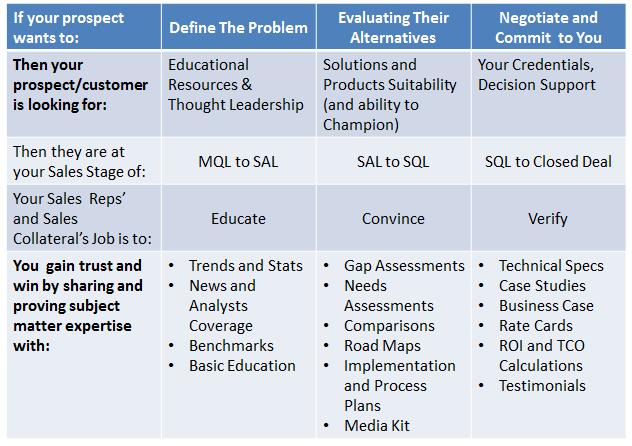 We are giving our marketing efforts “A Sales Quota.” To do this you need listen and document the conversation with the customer. As part of our services we map the entire sales conversation to identify the objections, and then create authentic digital content that addresses those needs and objections specifically to get deals through the pipe.
We are giving our marketing efforts “A Sales Quota.” To do this you need listen and document the conversation with the customer. As part of our services we map the entire sales conversation to identify the objections, and then create authentic digital content that addresses those needs and objections specifically to get deals through the pipe.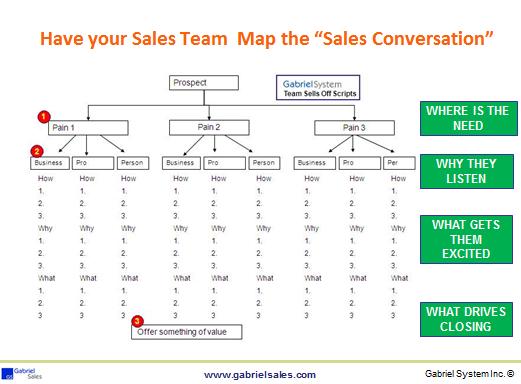
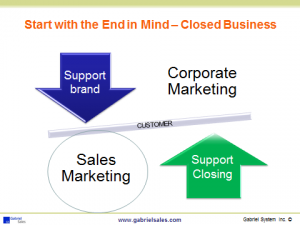 This blog discusses how Gabriel thinks about B2B Demand Generation and the hybrid role it plays in sales, sales marketing and market intelligence. In short, Sales Marketing is always supporting the close of business. In this blog we will share how you can close more B2B customers leveraging the opportunities in the new sales engagement model we now all face. This is Part 1 of a 3 Part Series.
This blog discusses how Gabriel thinks about B2B Demand Generation and the hybrid role it plays in sales, sales marketing and market intelligence. In short, Sales Marketing is always supporting the close of business. In this blog we will share how you can close more B2B customers leveraging the opportunities in the new sales engagement model we now all face. This is Part 1 of a 3 Part Series.